Pascal 80
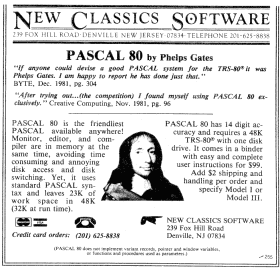
New Classics Software advertisement from the April 1982 issue of 80 Microcomputing
Pascal 80 was a Pascal development system for the TRS-80 Model I, III, and 4. It was written by Phelps Gates, also the author of APL-80, an APL compiler for the TRS-80.
The Pascal 80 package consisted of a full-screen text editor, monitor, and compiler. Pascal source code could be compiled directly to memory or to disk. Editing and compiling Pascal source code in memory made programming Pascal similar to using interpreted languages, such as BASIC. According to the Pascal 80 manual:
Efficient and compact code allows Pascal 80 to have a monitor, editor, and compiler in the computer at the same time, yet leave enough room to create programs up to 23K bytes, with an additional 9K available while the program is running for variables and work space. This allows programs to be written, compiler, edited, and compiled again without time consuming disk access.
When written to disk, resulting programs could either be created as p-code (an intermediate compiled format) or could be merged into standalone /CMD files.
Versions
Two different companies sold versions of Pascal 80: Ramware (a division of Softside magazine) and New Classics Software. The first version of Pascal 80 was released by Ramware in early 1981. That version worked only on a TRS-80 Model I with TRSDOS. The Ramware Pascal 80 was described by the manual as “basically Standard Pascal, with some restrictions and extensions.” Those restrictions meant that “pointer Variables, Variant Records, NEW, DISPOSE, WITH, GET, and PUT are not implemented in PASCAL 80.”
On March 22, 1982, New Classics Software released an enhanced version of Pascal 80 at the West Coast Computer Faire. This version of Pascal 80 was revised extensively by George Blank, the president of New Classics Software. It had many improvements, including Model III support. The price was $99.00, although it was later lowered to $79.00.
New Classics Software released several further revisions to Pascal 80 which addressed almost all of the limitations of earlier versions (including the lack of pointers). Later advertisements described Pascal 80 as a “nearly complete subset” of standard Pascal.
Due to the strict software export controls in place in the United States at the time, Pascal 80 couldn’t legally be exported to the Soviet Union. This led to New Classics Software’s memorable advertisement that described Pascal 80 as “too powerful for the Red Army.”
Other Products
Other Pascal 80 products sold by New Classics Software included:
- Pascal 80 Trial Version, a demonstration version of Pascal 80 that didn’t allow users to save files, for $15.00
- Pascal 80 Graphics extensions for the Radio Shack high-resolution board for $39.00
- Pascal 80 for CP/M for $39.00
- Pascal 80 School Package (either TRS-80 or CP/M) for $279.00. The Pascal 80 advertisements stated that “hundreds of schools, including top universities are now using Pascal 80 to teach Pascal.” The School Package, intended solely for schools, included support for the Radio Shack Network III networking hardware. According to George Blank in 1984, the School Package accounted for 40% of Pascal 80 income.
New Classics Software continued to advertise Pascal 80 until 1985.
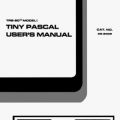
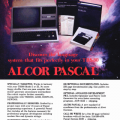
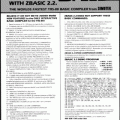
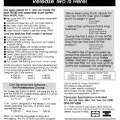










David Sutherland says:
re: “Radio Shack Network III networking hardware” — I looked, but could not find, much information on this topic.
(I think we had one of these in high school but I’ve not seen any emulator functionality for them.)
Would love to see an article on this.
Thanks for the continued good research! Great article.
David Sutherland says:
Also, am curious: What specific “support” did the Pascal 80 School Package include for the Network III? If the Radio Shack Network III, as I am guessing, was just a switch and amplifier hardware how did the software include support for it?
Matthew Reed (TRS80.org) says:
The Network 3 was more sophisticated than the Network I or Network 2 and allowed students to individually load and save files. I don’t know any specific details about the Pascal 80 support, but my assumption would be that it allowed students to save and load programs from the teacher’s computer and also to print on the teacher’s printer.
Mark McDougall says:
Interesting that there was a hires graphics extension for Pascal 80. I actually used Turbo Pascal for CP/M 2.2 on my Model 4P during my university days. One semester I was studying Computer Graphics, and wrote my own graphics library for the uLab Grafyx Solution for Turbo Pascal. At the end of the year I actually prototyped my Ray Tracing assignment (cutting edge back then – seriously!) on the 4P!!! I used 3 “colours” – back, white and checkerboard/dithered. Actually looked quite decent at the time… still have the source around somewhere…
Christopher Baughman says:
We had the networked system at my high school that we ran what was, I presume, Pascal-80. It was “new” my senior year. and was part of an AP computer science class. I can remember we loaded files and the start of class and saved them at the end of class, all to a single computer that had a HDD. Heady stuff for 1984 high school computer class.
Prof. J. W. Montgomery says:
I have been trying to use Pascal 80 on my TRS-80 with two external disk drives. I have the three 5.25 disks, the first of which is supposed to contain the essential files, and the detailed manual. The sample program complies just fine–but it will not run! I have tried saving it to the Pascal 80 disk 1 and also to the TRSDOS 2.3 boot disk; in both instances, compiling occurs but the program won’t run (the message is either “Parity error during read” or “No such file.” But the file appears in the DIR of the disk to which it was saved!
Can anyone help? I’m new to this and will gladly phone from France to the States to get some direct assistance from those more knowledgeable than I. Previously, I’ve used UCSD Pascal on an Apple II and a TI 99/4A–but this has me baffled.